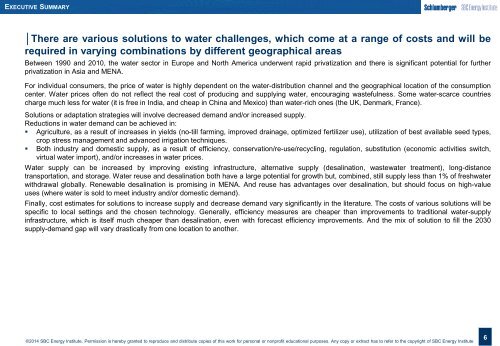1wMF53w
1wMF53w
1wMF53w
You also want an ePaper? Increase the reach of your titles
YUMPU automatically turns print PDFs into web optimized ePapers that Google loves.
EXECUTIVE SUMMARY<br />
│There are various solutions to water challenges, which come at a range of costs and will be<br />
required in varying combinations by different geographical areas<br />
Between 1990 and 2010, the water sector in Europe and North America underwent rapid privatization and there is significant potential for further<br />
privatization in Asia and MENA.<br />
For individual consumers, the price of water is highly dependent on the water-distribution channel and the geographical location of the consumption<br />
center. Water prices often do not reflect the real cost of producing and supplying water, encouraging wastefulness. Some water-scarce countries<br />
charge much less for water (it is free in India, and cheap in China and Mexico) than water-rich ones (the UK, Denmark, France).<br />
Solutions or adaptation strategies will involve decreased demand and/or increased supply.<br />
Reductions in water demand can be achieved in:<br />
• Agriculture, as a result of increases in yields (no-till farming, improved drainage, optimized fertilizer use), utilization of best available seed types,<br />
crop stress management and advanced irrigation techniques.<br />
• Both industry and domestic supply, as a result of efficiency, conservation/re-use/recycling, regulation, substitution (economic activities switch,<br />
virtual water import), and/or increases in water prices.<br />
Water supply can be increased by improving existing infrastructure, alternative supply (desalination, wastewater treatment), long-distance<br />
transportation, and storage. Water reuse and desalination both have a large potential for growth but, combined, still supply less than 1% of freshwater<br />
withdrawal globally. Renewable desalination is promising in MENA. And reuse has advantages over desalination, but should focus on high-value<br />
uses (where water is sold to meet industry and/or domestic demand).<br />
Finally, cost estimates for solutions to increase supply and decrease demand vary significantly in the literature. The costs of various solutions will be<br />
specific to local settings and the chosen technology. Generally, efficiency measures are cheaper than improvements to traditional water-supply<br />
infrastructure, which is itself much cheaper than desalination, even with forecast efficiency improvements. And the mix of solution to fill the 2030<br />
supply-demand gap will vary drastically from one location to another.<br />
©2014 SBC Energy Institute. Permission is hereby granted to reproduce and distribute copies of this work for personal or nonprofit educational purposes. Any copy or extract has to refer to the copyright of SBC Energy Institute<br />
6


